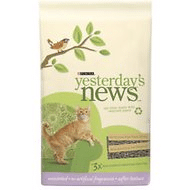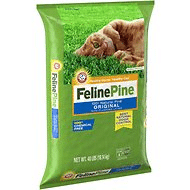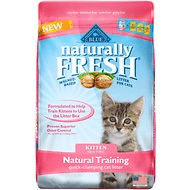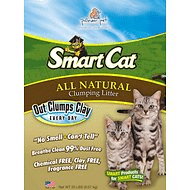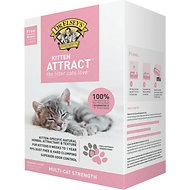What’s the Best Litter for Kittens? Top 5 Safe Litters for Your Kitten
Quick Guide
- What’s the best cat litter for kittens?
- What is the Best Litter for Kittens?
- Here’s how to select the perfect litter for your kitten.
- Top 5 Best Litters for Kittens
- Yesterday’s News Softer Texture Unscented Cat Litter Review
- Feline Pine Original Cat Litter Review
- Blue Buffalo Naturally Fresh Walnut-Based Kitten Training Quick-Clumping Cat Litter Review
- Pioneer Pet SmartCat All Natural Cat Litter Review
- Dr. Elsey’s Precious Cat Kitten Attract Training Cat Litter Review
- Tips for Training Your Kitten to Use the Litter Box
What’s the best cat litter for kittens?
Kittens have a natural desire to eliminate in sand or soil and start showing instinctive digging and covering behaviors when they’re as young as three or four weeks old.
They typically pick up on using the litter box quickly and require very little training. For most kitten guardians, litter training isn’t a huge problem. Selecting the right litter, however, can be more challenging.
Like babies of every species, kittens explore everything around them with an almost impartial enthusiasm. When your new kitten encounters the litter box, they’ll do plenty of investigation, often employing all of their senses, including their sense of taste. It’s not uncommon for kittens to take an experimental nibble at their new litter.
If you’re using the wrong litter, a little innocent curiosity could have serious health consequences. Clumping clay litter, specifically, can cause gastrointestinal distress and even intestinal blockage.
Until your kitten is 3-4 months of age, they should avoid clumping litters and opt for safer alternatives. By the time that kittens reach this age, they should have outgrown any litter consumption and their bodies should be large enough to handle some incidental ingestion as part of grooming. If your older kitten or cat continues to eat litter, it could be a sign of a mineral deficiency or health problem.
What is the Best Litter for Kittens?
Here’s how to select the perfect litter for your kitten.
Choose non-clumping litter for younger kittens.
Most clumping clay litters are made with sodium bentonite, which can expand 15-18 times its original size when it gets wet. In the litter box, this allows it to form hard, easy-to-scoop clumps and helps you to keep the litter box fresh.
In your young kitten’s tiny, delicate digestive tract, however, it could create a cement-like blockage and wreak havoc on their health.
Fortunately for our kittens’ wellbeing, there are numerous litter choices that won’t cause life-threatening blockages or gastrointestinal upset.
You can opt to use non-clumping clay instead of the traditional clumping clay litter.
Because it’s free from clumping agents, non-clumping clay litter won’t create solid, scoopable lumps and doesn’t do a good job of controlling odors. You’ll need to dump out all the contents of your litter box on a regular basis. While it’s not the most effective litter, it also won’t block your kitten’s plumbing.
You’ll find more options in the world of natural and biodegradable litter.
There are clumping litters made from corn, walnut shells, grass, wood, and wheat. These create solid clumps that make scooping easy. These types of litter are non-toxic, made from natural ingredients, and are completely biodegradable. Whether or not these all-natural clumping litters are safer for kittens is up for debate.
Marina Botinas, DVM, says: “I would introduce clumping litter after 3-4 months and before that you can use non clumping litters…I would stay away from the biodegradable clumping litters also because if ingested it can cause intestinal upset.”
At the same time, World’s Best Cat Litter, a company selling corn cat litter, says that: “Because World’s Best Cat Litter™ is made from all natural ingredients, any litter ingested will pass through the animal’s system naturally, not causing any intestinal blockages.”
Natural pellet-style litters are a good choice for young kittens.
These products are made from recycled substances like wood and paper.
Besides being non-clumping, another benefit of pellets is that their larger size keeps them from getting stuck to your kitten’s paws, reducing tracking and helping to keep your home clean.
Think about your kitten’s comfort.
Kittens have delicate paw pads and should use a comfortable litter.
Regardless of their age, cats usually prefer fine-grained litters that resemble the sand and soil that appears in nature’s litter box. Fine-grained litter is easy to dig in and is soft on kitten paws. Although fine-grained litters, including non-clumping clay, are the usual favorite, paper pellets are also known for their paw-friendly softness.
Paw-friendliness typically varies from product to product, but there is one type of litter that has an almost universal reputation for not being very comfortable on the paws: silica gel crystals.
Silica gel crystal litter is made from the same combination of silica dioxide, oxygen, and water that you’ll find within the desiccant packets commonly found along with moisture-sensitive products. Although the silica gel is non-toxic, the crystals have a hard, harsh texture that isn’t ideal for delicate kitten paws.
Avoid harsh fragrances.
This applies to all cat litter: most cats don’t like perfume and prefer to use unscented litters. Litter made with unnatural fragrances might mask natural odors a bit, making them appealing to humans. Cats don’t appreciate the masking effect and prefer a genuinely clean, fresh, and odorless litter box.
Opt for an unscented litter for your kitten.
Choose a litter that helps with training.
If your kitten is having a little trouble learning to use the litter box, consider using a litter designed to help with training. Some litters are made specifically for litter box users-in-training and contain herbal attractants that encourage cats to use the litter box.
Top 5 Best Litters for Kittens
Quick Look : Top 5 Best Training Litters for Kittens
At the top of the list, you’ll notice a couple of non-clumping biodegradable litters. These are ideal for very young kittens, but don’t offer the same hygiene and freshness that a clumping litter would provide. For those who would prefer a clumping litter, but don’t want to use sodium bentonite clay, biodegradable clumping litters may provide a safer alternative. You’ll also notice one clumping clay litter – this one is recommended for older kittens who need an extra push to use the litter box.
Here are the top 5 best products you can use in your kitten’s litter box:
Yesterday’s News Softer Texture Unscented Cat Litter Review
Recycled non-clumping paper pellet litter
Paper litter is a popular choice among those seeking a gentle, paw-friendly product. This litter is specifically designed to be softer than the original Yesterday’s News litter, making it perfect for delicate kitten paws.
This litter is made from recycled newspaper and, according to the company, is 3X more absorbent than clay. Because it’s not a clumping litter, you’ll need to change it out more frequently to keep odors to a minimum.
The litter is 99.7% dust free and won’t emit a plume of dust when you pour it into the litter box. It’s unscented with no artificial fragrances. – Buy It
Pros
- Soft on kitten paws
- Moderate odor control
- Highly absorbent
- Biodegradable and eco-friendly
- Non-clumping and safe for young kittens
Cons
- Doesn’t offer the best odor control
Feline Pine Original Cat Litter Review
Non-clumping pine pellet litter
Feline Pine uses highly absorbent pine fibers to naturally absorb liquid and lock in odors. The 100% pine pellets are safe for your kitten to dig in, don’t create clouds of dust, and are completely free from artificial ingredients, including added fragrances.
Instead of clumping, the pine pellets break down into sawdust when they come into contact with moisture. Each day, you’ll need to scoop out solid waste and gently stir the litter to move fresh pellets to the top and the sawdust to the bottom of the pan.
Some kittens may not like the feeling of the pellets underneath their paws. – Buy It
Pros
- Highly-absorbent pine naturally locks in odors
- Doesn’t clump
- Dust-free
- Unscented with no chemicals or additives
Cons
- Kittens may not like the sensation of pine pellets under their paws
Blue Buffalo Naturally Fresh Walnut-Based Kitten Training Quick-Clumping Cat Litter Review
Clumping walnut litter with an herbal kitten attractant
This litter uses the natural odor-absorbing properties of walnut shells to control litter box smells without any artificial fragrances. According to Blue Buffalo, this natural blend of US – grown walnut shells absorbs 3X more than the leading brand of clay litter.
It’s a naturally clumping litter that encourages a quick and easy cleaning experience – plus it’s virtually dust-free.
What makes this litter so appropriate for kittens is its ability to encourage your kitten to use the litter box. It contains a blend of natural herbs that can naturally draw kittens to the litter. If your kitten needs a little help getting started using the box, this product may be a good choice. – Buy It
Pros
- Contains a blend of herbs selected to attract kittens to the litter box
- Highly absorbent
- Excellent odor control
- Virtually dust-free
- Cats like the texture of the litter
Cons
- Tends to stick to cat paws and track through the house
- A clumping litter
Pioneer Pet SmartCat All Natural Cat Litter Review
Clumping grass litter with a fine texture
This grass litter has a fine, sand-like texture that kittens love to walk and dig in. It provides excellent odor control naturally without using any added fragrances. The litter creates solid clumps that are easy to scoop, helping to keep the litter box clean and fresh
It’s 99% dust-free, made without any additives, and is lightweight, so transporting and pouring the litter is easy.
The grass used in this litter is farm-grown in the United States and is certified GMO-free. – Buy It
Pros
- Cats love the fine, soft texture of the litter
- Great odor control
- Natural clumping ability
- Free from any artificial ingredients and fragrances
Cons
- An expensive litter
- Clumping litter
Dr. Elsey’s Precious Cat Kitten Attract Training Cat Litter Review
A clumping clay litter for older kittens
If you have an older kitten and need some help with litter training, this litter can make life easier. It’s a clumping clay litter, so it’s not appropriate for young kittens. The litter has a fine granule size and texture that’s gentle on kitten paws and features a kitten-specific herbal attractant to encourage reluctant kittens to enter the box.
Reviewers seem to particularly appreciate the texture of the litter, which is perfect for cats with sensitive paws.
Besides all of its kitten-targeted features, this litter delivers great odor control, excellent clumping ability, and is 99% dust-free.
The litter comes with a free “Litter Box Solutions” booklet. – Buy It
Pros
- Texture and granule size are perfect for sensitive kitten paws
- Features an herbal attractant to help with litter box training
- Effective odor control
- Fragrance-free
Cons
- A clumping clay litter – not appropriate for kittens younger than 3-4 months old
Tips for Training Your Kitten to Use the Litter Box
Kittens instinctively seek out soil and sandy areas in which they can bury their waste, so starting to use a litter box is usually a process directed more by instinct than training. That said, you’ll need to point your kitten in the right direction, and not everyone takes to the box right away. Here are some tips to help you train your kitten to use the litter box:
- First of all, choose a litter box that’s right for your kitten. Select one with adequately low sides that allow your kitten to get in and out with ease. Some high-sided litter boxes feature a lowered entryway that’s just low enough to make accessing the box simple.
- Think about placement. It’s recommended that you provide one litter box for each cat in the home, plus one extra. Place the litter boxes in calm parts of the house – not a high-traffic area or a noisy room.
- Get your kitten acquainted with the box. At a quiet moment, gently place the kitten into the box and demonstrate how to scratch in the litter. Repeat this at times when your kitten might normally use the litter box – in the morning, after naps, and following a meal.
- Until your kitten catches on to the litter box, it’s not a good idea to leave them home alone with the ability to go anywhere in the house. Unattended kittens should be confined to a room with non-porous flooring, food, water, a place to rest, and a clean litter box.
Again, using the litter box makes intuitive sense to cats. Most litter box problems stem from poor maintenance – not a lack of proper training. During training and beyond, the most important thing is to fill the box with a cat-friendly litter and keep it fastidiously clean.


